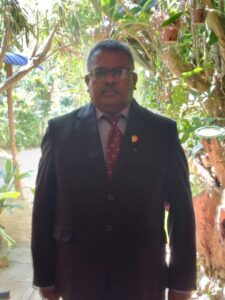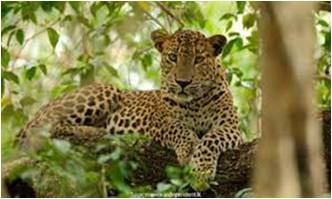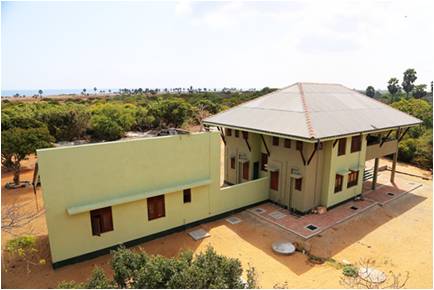Episode 18 – Chundikulam National Park

The end of the leopard
In 2019, I worked as the Assistant Director in charge of Kilinochchi area. Kilinochchi area has 2 National Parks. Those areChundikulam and Delft National Parks.
There are small lakes in Chundikulam area. Migrant birds are first to set foot in the ChundiKulam area. Thousands of migratory birds are in the lakes. During the rainy season, these lakes are filled with water. During that time, the migrant birds are abundant in Vankala Sanctuary of Mannar.
There are turtles along the coast in this area, especially the Olive Ridley turtles. Fishermen are engaged in fishing activities on the Northern coast. Turtles get caught in their nets. Because of those practices legs and head of those turtles get injured. There are also cases of illegal transportation as well. There are cases where they are caught and handed over because it is illegal, and there are cases where legal actions were taken. Most incidents are caught by the police. Apart from Batu turtles, other species of turtles are rarely caught.
One day when I was in the Nilinochchi office, I received a message that a leopard had come to the village. The name of the village is AmbalaKulam. It is a little far from my office. I immediately sent a group there. Later a message came from them that the leopard is trapped in the village whilethey will inform the vet and the leopard can be protected as well.
Later the vet also came there. But when the vet was ready to tranquilize the animal, the people behaved riotously. In this commotion, the leopard jumped on to the back one of our officers. The claws of the leopard cut and scratched the flesh severely. Two people have taken the injured officer to the hospital. The riotous behavior of people increased. They have obstructed our work. Meanwhile, the animal started chasing after the people. Then the people took axes and went to fight with the leopard.
By that time, I was also able to come close to the area. But the police said people were behaving in a restless manner and to wait for a while. At the same time, I heard the news that the leopard had been killed.
When we reached, people were attacking the animal with axes. They were takenselfies with the dead leopard carcass. People behaved as if they had done a great act of heroism. They were shouting loudly.
We went to the police with the body of the dead leopard. We reported to Kilinochchi Magistrate Court regarding this incident. The photos taken by those people are posted on Facebook. We took it and reported it to the court. The court ordered the police to arrest everyone involved and the police arrested about ten to fifteen people.
The case is still pending. When I remember the incident, I feel sorry for not being able to save the leopard.
Mr. G. U. Saranga

Mr. G. U. Saranga joined the Wildlife Department in 1983 as a Ranger and he was fortunate to work in various National Parks and Sanctuaries. He received his basic training at the Yala and Wilpattu Sanctuaries. He was in charge of the Sigiriya Sanctuary and later worked at the Minneriya National Park and then at the Wasgamuwa National Park for seven years. He also served as Park Warden at Horton Plains National Park from 2004-2005 and 2009-2002. Mr. Saranga was later promoted to Assistant Director and was in charge of the Kilinochchi area and later the Ampara area. He is currently in charge of the Vavuniya region.
Mr. Saranga completed a 9-month Diploma course awarded by the Department of Wildlife in 1995 and trained for three months at the Wildlife Institute in Dehradun, India. He has also completed short training courses in countries such as Korea, the Philippines and Thailand.
Mr. Saranga’s house is located in Katugastota, Kandy.
Chundikulam National Park
Chundikulam National Park can be introduced as a wetland ecosystem located near the Jaffna Peninsula in the Northern Province of Sri Lanka, with high biodiversity as well as a unique aquatic and coastal ecosystem. With a total area of 19565.33 hectares, this area was first designated as a sanctuary on 26th February 1983 and was declared a National Park on 22nd June 2015 under the provisions of the Fauna and Flora Protection Ordinance. The park is located between Puchchilaippally and Karachi and the nearest city is Kilinochchi.
Chundikulam Park is located in a lagoon ecosystem, so both freshwater and brackish land forms can be seen here. Located at the sea level height, this is a plain area made up of a combination of several ecosystems showing lowland tropical climate and the salinity of the water also changes from time to time. The rains are brought by the Northeast monsoon and convectional rains while during period from April to September of the year shows a dry weather condition here.
A high diversity of plants can be seen in this park made up of several ecosystems. Accordingly, about 187 plant species have been found, and a large number of them are plant species that grow in wetlands. Mangrove swamp species and sea grass species can be seen in abundance. Grey mangrove (Avicennia marina),Black mangrove(Lumnitzera littoralis), Thatch screw pine (Pandanus tactorius), Red mangrove (Rhizophora mucronata), Mangrove apple (Sonneratia caseolaris) are the mangrove species found here. Although there are no fully grown trees within the park, Palmyra plam(Borassus flabellifer) occasionally found. In addition, around 18 aquatic plant species have been identified in here.




Chundikulam National Park is rich in faunal diversity as it comprises of both wet and dry ecosystems. That is, due to the abundance of food in these ecosystems and the availability of suitable places to breed their species, about 136 species of birds have been identified, and many of them are migratory birds. Bar-tailed godwit (Limosa lapponica),Greater flamingo (Phoenicopterus roseus), Black-winged stilt (Himantopus himantopus), Brown headed gull (Chroicocephalus brunnicephalus), Common sandpiper (Actitis hypoleucos), Eurasian curlew (Numenius arquata), Gull-billed tern(Gelochelidon nilotica),Marsh sandpiper (Tringa stagnatilis), Black-headed ibis (Threskiornis melanocephalus)can be identified as most common bird species found in here.





Leopard (Panthera pardus kotiya),Sloth bear (Melursus ursinus), Spotted deer (Axis axis ceylonensis) and 26 other species have been identified as the mammals found in here. Mugger crocodile (Crocodylus palustris), Estuarine crocodile (Crocodylus porosus) are the two crocodile species live in this.



Also, 08 species of amphibians, 05 species of reptiles, one species of turtle, 34 species of salamanders, 20 species of frogs, 30 species of aquatic vertebrates and 17 species of aquatic invertebrates have also been identified in recent studies.
The total distance from Colombo to the park is approximately 361km. A person approaching Chundikulam National Park can enter the park by passing through Negombo – Puttalam – Anuradhapura – Rabewa – Medavachchiya – Kilinochchi – Alimankada – Iyanachchi Junction – Kuveni Junction and can also approach the park through Nittambuwa – Kekirawa – Tirappane – Mihintalea – Rabewa – Medavachchiya – Kilinochchi route.

Tourists coming to visit Chundikulam National Park can be accommodated in the tourist bungalow near the beach, which is maintained by the Department of Wildlife Conservation and can provide accommodation for about ten people. while the bookings can be done from the head office of the Wildlife Conservation Department, Battaramulla, Colombo.
List of animals in the Chundikulam National Park
Sinhala Names | Tamil Names | English Names | Botanical Name |
කොටියා | புலி | Leopard | Panthera pardus kotiya |
වලහා | தேன் கரடி | Sloth bear | Ursus ursinus |
මුවා | மான் | Spotted deer | Axis axis ceylonensis |
වයිරපෙද ගොහොදුවිත්තා | பட்டைவால் மூக்கன் | Bar-tailed godwit | Limosa lapponica |
රජ සියක්කාරයා | பெரும் பூநாரை | Greater flamingo | Phoenicopte rusroseus |
කළු පිය ඉපල්පාවා | நெடுங்கால் உள்ளான் | Black-winged stilt | Himantopus himantopus |
බොරහිස් ගල්වියා | பழுப்புத்தலை கடற்பறவை | Brown headed gull | Chroicocephalus brunnicephalus |
පොදු සිලිත්තා | சாதா உள்ளான் | Common sandpiper | Actitis hypoleucos |
යුරාසියා කලිත්තා | பெரிய கோட்டான் | Eurasian curlew | Numeniu sarquata |
ගුලුතුඩු මුහුදුලිහිණියා | பருத்த அலகு ஆலா | Gull-billed tern | Gelochelidon nilotica |
වගුරු සිලිබිල්ලා | சின்ன பச்சைக்காலி | Marsh sandpiper | Tringa stagnatilis |
හිසකළු කෑදෑත්තා | வெள்ளை அரிவாள் மூக்கன் | Black-headed ibis | Threskiornis melanocephalus |
හැල කිඹුලා | சதுப்பு முதலை | Mugger crocodile | Crocodylus palustris |
ගැට කිඹුලා | செம்மூக்கு முதலை | Estuarine crocodile | Crocodylus porosus |
List of trees in the Chundikulam National Park
Sinhala Name | Tamil Name | English Name | Scientific Name |
කඩොලාන විශේෂ | சதுப்புநில புதர்கள் | Mangrove swamp Sps | |
මුහුදු තණකොළ | கடற் புட்கள் | Sea grass | |
කිරල | கிண்ணை | Mangrove apple | Sonneratia caseolaris
|
තල් ශාකය | ஆசியப் பனை | Palmyra Palm | Borassus flabellifer |
මන්ඩා | சாம்பல் சதுப்பு நிலம் | Grey mangrove | Avicennia marina |
මහ කඩොල් | சிவப்பு சதுப்பு நிலம் | Red mangrove | Rhizophora mucronata
|
බේරියා | கறுப்பு சதுப்பு நிலம் | Black mangrove | Lumnitzera littoralis
|
මූදූ කෙයියා | கைதை | Thatch screw pine | Pandanus tectorius |
Editor– DammikaMalsinghe, Additional Secretary,Wildlife and Forest Resources Conservation, Section, Ministry of Agriculture and Wildlife and Forest Resources Conservation (MAWFRC)
Article on park written by– HasiniSarathchandra, Chief Media Officer, Department of Wildlife Coservation (DWLC) MaheshaChathuraniPerera (Graduate Trainee), (DWLC)
Tamil Translations– A.R.F. Rifna, Development Officer, MAWFRC
English Translations – Asoka Palihawadana, Translator, MAWFRC
Web Designing–N.I.Gayathri, Development Officer,MAWFRC -C.A.D.D.A. Kollure, Management Service Officer, MAWFRC
Photography– pictures are from internet.